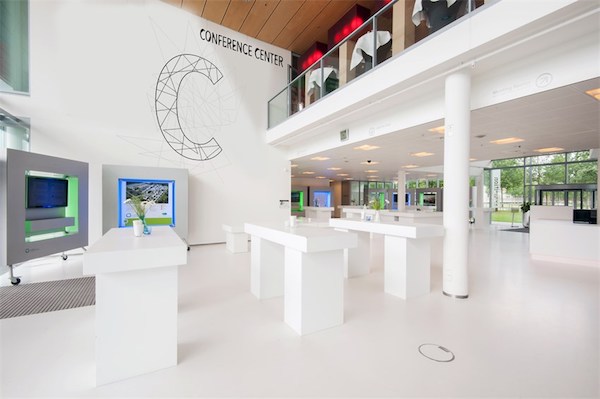
HIGH TECH CAMPUS EINDHOVEN CONFERENCE CENTER
We have an update with more details about the CERN Hackathon coming up 2 July at the Conference Center on High Tech Campus Eindhoven.
This promises to be a landmark event for Eindhoven as HighTechXL brings together the world’s most advanced research center and Eindhoven’s Brainport ecosystem. This is all part of a new collaboration that includes Nikhef, HighTechXL and Geneva-based CERN to recruit or form startup teams capable of turning CERN technology into companies.
This is all about technology transfer from CERN’s labs in Switzerland to the public domain including the healthcare sector, next-gen tech uses and any scientific application you can think of.
“The collaboration unlocks the hidden commercial potential of disruptive CERN technologies,” said HighTechXL founder Guus Frericks. “It provides a unique opportunity for high-tech industry experts who have ever dreamt of creating their own company – and were waiting for the right opportunity – to become a founding member of a new fast-growing high-tech company.”
That said, HighTechXL officials are making clear that you can participate in the hackathon even if you don’t aspire to be a founder.
CERN Hackathon organizers say this is a community event, with a goal of building diverse teams with a broad range of skill sets. If you have experience in marketing, sales, R&D, finance or IP, this is for you. Savvy marketers, tech visionaries, UX talent and developers … you’re invited!
Here are more details about what to expect including an introduction to the technology that will be presented.
• Accurate temperature control using CO2
Evaporative cooling using carbon dioxide is a technology for systems with high power density, providing highly stable and efficient cooling using small pipes that can extend over long distances. In addition, CO2 is substantially cheaper than fluorocarbon refrigerants and has a much lower negative impact on the environment. The 2-Phase Accumulator Controlled Loop and Integrated 2PACL systems developed by CERN and the Dutch National Institute for Subatomic Physics (Nikhef) make use of evaporative cooling based on CO2, for high thermal control of electronic equipment over long distances.
Possible applications: Cooling instrumentation and electronics including servers and routers at data centers
• Long Distance Structured Laser Beam
A simple, low-cost system and method for generating a structured laser beam that can propagate over large distances while maintaining a low divergence and small central spot size. This technology has been jointly developed by CERN and the Institute of Plasma Physics of the Czech Academy of Sciences. The parameters of the system can be easily adjusted to modify the focus and divergence of the beam. Furthermore, the SLB can reform around an object placed in its path, potentially making it usable for multipoint alignment systems. The system can be used for a wide range of wavelengths and, depending on the setup, is very robust to jitter, vibrations, and variations in the angle of the input beam; it also appears to be robust to fluctuations in air temperature. These properties make the SLB potentially suitable for use in a large number of application domains.
Possible applications: Metrology, Large-scale and Geodetic Metrology, Alignment, Satellite communication, Gas detection, Microscopy, Medicine, Optical tweezers, Laser shows, and more.
• Compact High-Frequency Particle Accelerator
As part of the Medical Applications Programme at CERN, a novel very compact high-frequency radio-frequency quadrupole linear particle accelerator has been developed. A single 1-metre HF-RFQ module can reach an energy of 2 MeV, or two modules can provide higher proton energies (5 MeV in ~2 metres). The HF-RFQ can be used as a stand-alone accelerator or as an injector/booster in larger accelerator installations. The main advantages are the compact size, low beam loss, modular design, distributed RF feeding and relatively low construction cost compared to other RFQ technologies. Although the first HF-RFQ was developed for use in proton therapy, the design can be easily repurposed for a wider range of applications.
Possible applications: Radiation therapy, medical isotope production and ion beam analysis
Here are some FAQs from CERN Hackathon organizers:
Can I apply if I don’t want to be a co-founder of a new venture based on CERN tech?
In short, YES. The CERN Hackathon is the first step in exploring possible business applications of the technology. If you believe you can contribute in this exploration process, you are welcome to apply, and your application will be considered in the selection process. There will be other roles to play as we move forward, including team mentors, advisors etc.
I am not an engineer or techie, do I still qualify?
In short, YES. Organizers are looking to set up diverse teams also in terms of experience. To find the best applications of technology, they need team members who have experience in marketing, sales, R&D, finance, IP etc. Organizers are building very diverse teams with a broad range of skills in the team setups. So, savvy marketers, they need you. Visionaries, UX talent and developers, team leaders and process specialists are also needed.
What exactly will happen on July 2nd and what are next steps?
The CERN Hackathon is all about exploring the best applications of these technologies and the impact they can bring to a specific industry and/or customer segment. Based on the propositions created by hackathon teams, you will be invited to build your proposition further during the month of July and August and submit your applications to the HighTechXL, CERN technology business accelerator with your team, which starts 24 September 2018. There will be more information about the complete process during the hackathon.
When will I know if my application has been selected?
Organizers already are reviewing applications on the way to notifying the first teams and individuals. Applications are open until 25 June. However, applications are prioritized on a first come, first served basis. So if you haven’t applied yet and wish to participate, don’t wait until the last minute.
And one last thing: Have fun. This is a hackathon like no other. You’ll have a unique experience working with the most innovative team members on the coolest technology available. Unless you smash particles together for a living at a subterranean Swiss collider, you won’t have experienced anything like this.
Here’s the schedule of events for CERN Hackathon:
• The CERN Hackathon will open at 11:30 on Monday, 2 July with a welcome coffee and keynote.
• After the keynote, there will be a presentation explaining the three technologies.
• After that presentation, teams will get two hours to work on formulating propositions around the three CERN technologies, then submit their proposals. Finally, each team will make a pitch, with the hackathon wrapping up at 6 p.m.
• Selected teams will begin the business validation and formal business-building effort 24 September, with the accelerator running through 14 December.
• If you’re applying to the CERN Hackathon as an individual, you’ll be assigned to a team based on the qualifications and interests you list in your application profile. And of course, if you apply as part of a team, you’ll work together with your group and possibly people assigned to you.
You can apply here for the hackathon.
About CERN:
CERN has member states who make a contribution to the capital and operating costs of its programs and, together with a number of associate members states, they make possible the study of the basic constituents of matter. In 2012, CERN adopted CERN Easy Access, a technology transfer initiative to make it easier for businesses and entrepreneurs to access intellectual property generated by its researchers.
CERN funds and administers a number of research centers and projects, including two linear accelerators and several colliders including the Large Hadron Collider. But it’s in the medical technology domain that physics research, including the work done at CERN, CERN has had a major impact, with magnetic resonance imaging, positron emission tomography and other technologies. “In the medical world, if it weren’t for the all the physicists, there would be a lot less innovation,” said Dr. Visser.
About NIKHEF:
The National Institute for Subatomic Physics, or Nikhef, is based in Amsterdam. Nikhef is the Dutch organization that carries out research into the elementary building blocks of our universe, their mutual forces and the structure of space and time. Nikhef partners with CERN on the Nikhef-CERN Business Incubation Center.
About HIGHTECHXL:
HighTechXL is the Netherlands’ premier high-tech accelerator, focusing mostly on hardware since its inception in 2014. HighTechXL is an initiative of the Eindhoven Startup Alliance with ASML, Philips, NTS group, High Tech Campus Eindhoven, ABN AMRO Bank, Brabantse Ontwikkelings Maatschappij and EY as its members.
About Brainport:
Brainport is the main economic-development agency for the Brabant Region that includes Eindhoven. Brainport is the fastest growing regional economy in the Netherlands, up 4.9 percent in 2017 compared to 2016.














